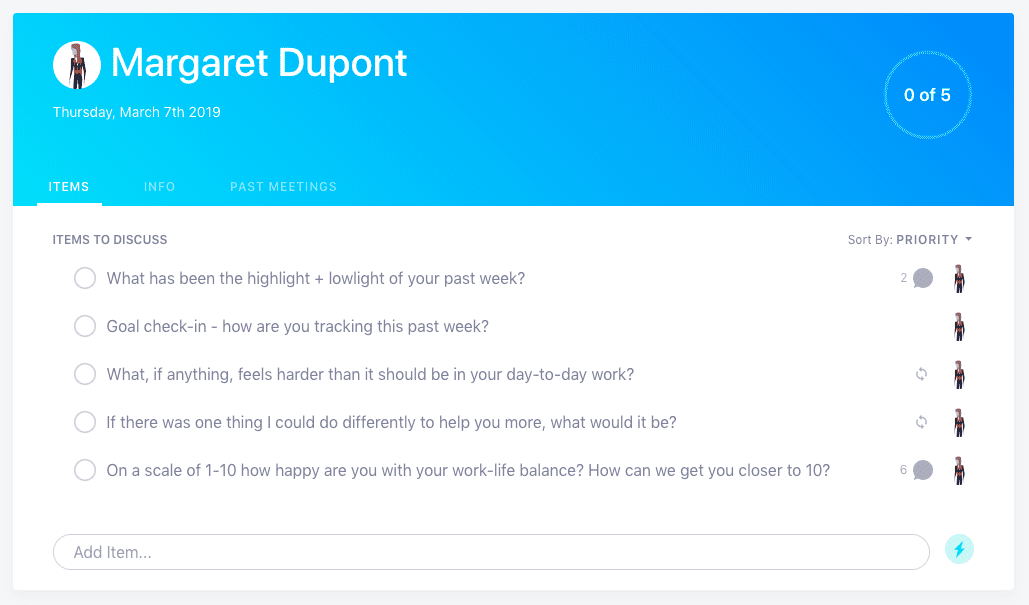The manager’s agenda template for one-on-one meetings with employees
At Hypercontext, we believe that one-on-one meetings with employees are the most important thing on a manager’s calendar. Done right,…
Warning: Undefined array key "category" in /www/hypercontext_216/public/wp-content/themes/Soapbox/hype-files/sections/article/content.php on line 10
At Hypercontext, we believe that one-on-one meetings with employees are the most important thing on a manager’s calendar. Done right, they’re where you check in on the progress of goals, collect feedback, share wins and detect early signs of issues.
Our one-on-one meeting agenda template is a great starting point for any recurring one-on-one meetings with employees.
Think of this one-on-one template as an à la carte menu of one-on-one meeting topics: you can pick and choose the items you like, and edit or remove the ones that don’t feel natural to you. No matter what, it will help you lay the foundation for meaningful, productive weekly conversations with your team members.
Click here to jump to see the Hypercontext one-on-one meeting template in action!
1. What has been the highlight + lowlight of your past week?
This is at the top of our one-on-one meeting template. Opening your one-on-one meeting agenda with a broad question like this allows you and your direct report to ease into the conversation and slowly allow all the hustle and bustle of the rest of the day fade away for the next 30 minutes.
It also gives you a chance to get a read on where your employee is at. If they go right to the highlight with a beaming grin, you know they’ve had a pretty great week. If they skim over the highlight and have lots to say on the lowlight, this is a warning sign that it hasn’t been the best week for your direct report. If that’s the case, you might want to give this agenda item an additional five to 10 minutes to make sure you’ve got all the context you need about the situation.
2. Goal check-in – how are you tracking this past week?
A regular check-in on goals in your one-on-one is an awesome way to celebrate wins that have occurred since your last check-in or identify potential blockers. As a manager with several reports, it’s extremely difficult to keep up with what everyone on your team is working on and achieving on a day-to-day basis, so use your one-on-one time to help you with that!
Pulling up the goals that your employee set for themselves at the beginning of that quarter or month will give you a chance to celebrate the progress being made – and also offer an opportunity to brainstorm ways to improve progress, if needed.
3. What, if anything, feels harder than it should be in your day-to-day work?
There are a couple of ways to phrase this one (you could also ask, “what about your day-to-day processes would you change?”), but ultimately it’s an agenda item that facilitates checking if there is potential for productivity improvement.
Phrasing it as “what feels harder” versus “what is broken” sets the conversation on a more solution-oriented path. The goal here is to create a habit of regularly reviewing their daily tasks and making sure they’re being done in the most effective way possible!
4. If there was one thing I could do differently to help you more, what would it be?
Feedback. Feedback. Feedback.
You can’t share feedback (and expect your team to receive it well) if you don’t set a good example by inviting feedback for yourself!
People know that feedback is good. They know sharing it will help you get better. But unfortunately, common sense is not common action. Repetition is needed to help us create habits and solidify beliefs. So every week, have an agenda item inviting constructive criticism from your team.
5. On a scale of 1-10 how happy are you with your work-life balance? How can we get you closer to 10?
Wrap up your one-on-one meetings with employees with a check-in on their mental and physical well-being. A positive and healthy balance will mean that you’re getting the very best out of your employees when they’re at work, and will help ensure they’re enjoying the journey too.
If someone is burning the candle at both ends, it will only be a matter of time before they burn out. So asking this question gets you a quick pulse check on how they’re feeling, shows them you care, and will help you take action if and when it’s needed!
Bonus Questions:
Ready to personalize your one-on-one meeting template with a few other agenda items? Here are few more tried-and-true winners we recommend:
- What are the biggest time wasters for you each week?
- Is there anything we should start doing as a team?
- Would you like more or less direction from me on your work?
- Do you feel you’re getting enough feedback on your work? If not, where would you like more feedback?
- What could I do as a manager to make your work easier?
- Is there an aspect of your job you would like more help with?
- Do you feel you’re getting enough feedback?
- How could we improve the ways our team works together?
- What are you least clear about, in terms of our strategy and goals?
Your Hypercontext one-on-one meeting template 👇
Use this one-on-one meeting template free with Hypercontext
What to do next
Next, here are some things you can do now that you've read this article:
- You should check out our massive (& free) collection of meeting agenda templates to help you run more effective meetings.
- Check out Spinach to see how it can help you run a high performing org.
- If you found this article helpful, please share it with others on Linkedin or X (Twitter)

